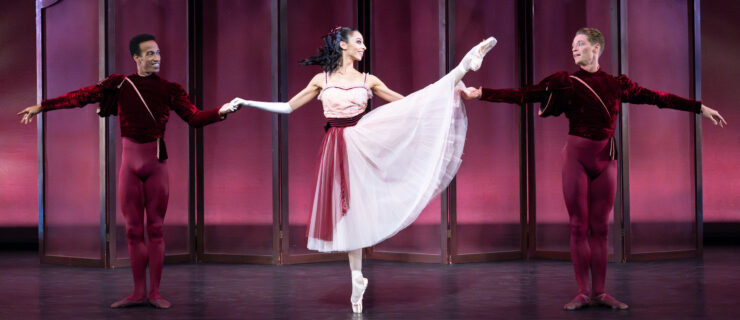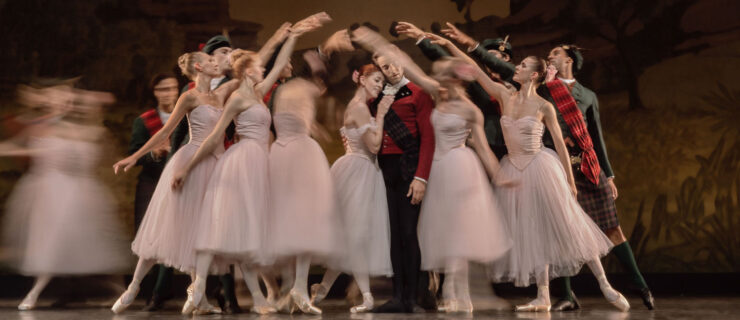Our Best Tips: Stretch and Strengthen Your Développé Devant
Everybody wants a higher extension, but achieving your best line is a long-term effort that includes both flexibility and strength. Here are two of our best tips on how to improve your développé devant by engaging and releasing the hard-to-find psoas muscles.
Controlled extensions to the front are not only physically difficult, but they’re sometimes hard to understand anatomically. Obviously, you want to work on increasing your flexibility with daily hamstring stretches. But often, the culprit is a weak iliopsoas—a group of deep core muscles that attach at the spine and run through the abdomen to the front of the hip. Your iliopsoas is crucial in lifting the leg, but it’s tough to find, and even tougher to activate.
Try this iliopsoas strengthener recommended by kinesiologist Karen Clippinger, author of Dance Anatomy and Kinesiology: Tie a medium-weight Thera-Band around your legs just above the knee and lie back on your elbows with your knees bent and feet lifted off the ground. Your pelvis should be tucked under at first to help you find your iliopsoas. Pull one knee in towards your chest, straighten the leg without letting the knee move away from the torso (it’s okay if you can’t fully straighten it) and return to the starting position, repeating six times on each side (eventually increasing to 10 reps). As you gain strength, practice the exercise with a more neutral pelvis, and gradually progress from leaning on your elbows to a more vertical position leaning on your hands.
Another exercise is to simply place the leg on the barre in croisé devant, keeping the hips square and lifting out of the supporting hip. Rotating from the top of the hip, feel a lengthening, spiraling energy through the working leg and lift it off the barre. Hold for five counts and slowly lower. Don’t worry if you can only lift it a few inches—this exercise will strengthen your deep turnout muscles, which will take pressure off the quad and create support from underneath.
—Amy Brandt
If you constantly find yourself reaching for a foam roller, you’re not alone. “Dancers’ hip flexors are very often tight because of how much they use them every day,” says Michelle Rodriguez, founder and director of Manhattan Physio Group. Each développé devant and cambré forward fires this set of muscles, so it’s no wonder why dancers complain of the chronically tight spot. Here, Rodriguez offers her tips for a proper lunge that stretches not only the tensor fasciae latae, psoas and iliacus muscles, which all help flex the hip, but also the quadriceps. “Ideally this stretch should be done every day, even on your day off from dancing,” says Rodriguez. Save it for after barre when your body is warm, or at the end of class or rehearsal.
1.
To set up to stretch your right side, kneel on your right knee. Rodriguez says you can position a towel or legwarmer underneath to cushion it if necessary. Place the left leg in front of you with your knee bent to about 90 degrees. You can place your hands on top of your knee, or hold on to the barre with one hand for balance.
2.
Firmly squeeze your lower right gluteals, and zip up your abdominals from your pubic bone to your belly button. “By activating these muscles, you will be able to place your pelvis in the best position to maximize the stretch,” she says. You should now feel it in your right hip and thigh.
3.
Throughout the stretch, keep the thigh you’re kneeling on vertical. “A very common mistake dancers make is to go too far into a much deeper lunge,” says Rodriguez. If you use a larger range of motion, you risk getting less of a stretch in the tensor fasciae latae, psoas, iliacus and quadriceps.
4.
Once you can maintain the shape with proper muscular engagement, only then should you slowly lunge forward, says Rodriguez, towards the end of the stretch.
Repetitions
: Hold for 30 to 60 seconds and repeat on the other side. Do two complete sets.
—Madeline Schrock
For more news on all things ballet, don’t miss a single issue.





